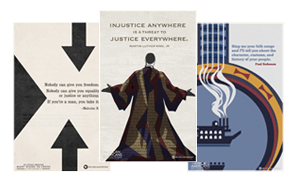Civil Disobedience and Social Change ~ Lesson Activities
Lesson Activities
INTRODUCTORY ACTIVITY
1. Ask your students what it takes to make big societal changes come about. For example, if they wanted to institute a new rule saying that teachers in your school would not be allowed to assign homework, what would they have to do? Would this change happen easily? Would it take a long time? What steps might they take in order to get a new rule like this in place? Can an individual make a difference?
2. Explain that throughout history, there have been times when people felt so deeply about a political or social issue, they resisted the status quo—the current state of affairs—in some manner. Some of these strategies were effective, some were not.
3. Tell your students that you will be examining different ways people have behaved in an effort to bring about big societal changes. Assign each student in your class a number from 1-4. Distribute the “Calculated Acts” document to each student.
Tell your students to examine the photograph or image matching the number they’ve been assigned. A hint accompanies each image and provides some additional information.
As they examine the image, write the following questions on the board, and ask them to answer them in their notebooks or on a separate sheet of paper:
• Do you know what this event is?
• What do you think these people are resisting or trying to change?
• What words would you use to describe their actions?
• Do you think they were successful in making a big change happen? Why or why not?
5. Review the images as a class. Ask the students their responses to the questions they’ve been asked to consider. After you have reviewed each image, ask your students what similarities and differences they notice in the images. Did the Boston Tea Party resolve all of the American colonies’ arguments with Great Britain? Did the slaves escaping on the Underground Railroad end slavery? Did one woman’s arrest at the White House get women the right to vote? Do they think these individual acts brought about big changes? Why or why not?
6. Explain that all of these images depict acts of “civil disobedience.” Project or write on the board the following quotes about civil disobedience:
“If the machine of government is of such as nature that it requires you to be of injustice to another, then, I say, break the law.” –Henry David Thoreau
“One has a moral responsibility to disobey unjust laws.” –Martin Luther King, Jr.
7. Ask your students to, based on the images they’ve examined and these two quotes, develop a definition for civil disobedience. (A possible definition is “the refusal to uphold certain laws or meet certain governmental demands in an effort to make change happen.”) Explain to your students that there are multiple types of civil disobedience (peaceful and violent, public and private, etc.), and that during this lesson, they will be looking at one example in depth.
Find educational resources related to this program - and access to thousands of curriculum-targeted digital resources for the classroom at PBS LearningMedia.
Visit PBS Learning Media






